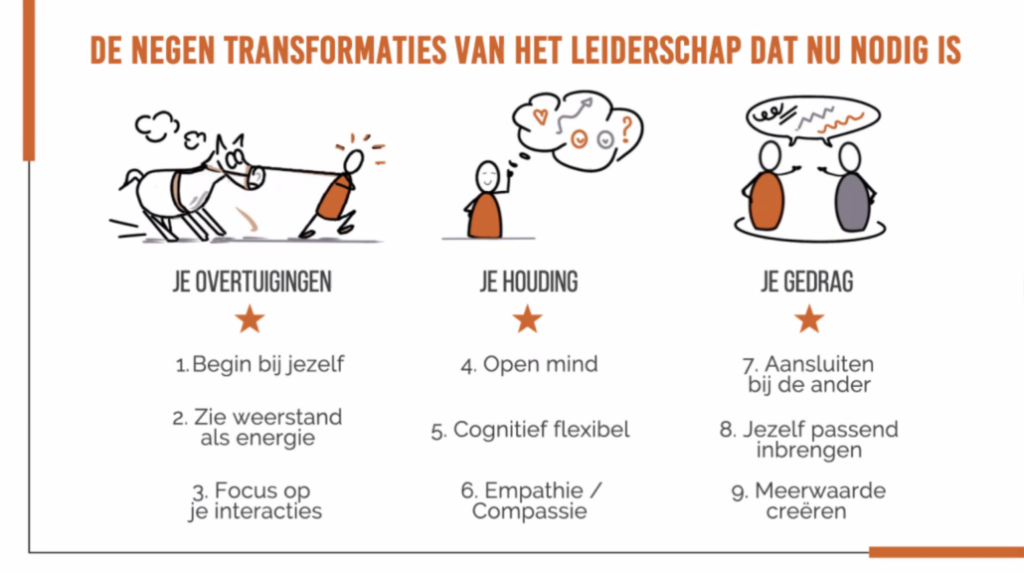Thursday 29 September saw another UMIO Prime webinar Nieuw als Leidinggevende, attended by around 50 participants. Frans Wilms, leadership expert and trainer of the Dutch leadership programme Opleiding Verbindend Leiderschap, took us through an innovative leadership approach that helps organisations take steps forward in complex situations.
No matter what environment your organisation is operating in, complexity and unpredictability are increasing. This is accompanied by a high degree of uncertainty, which means you can no longer manage on your own. Not even with the systems we have at our disposal. It is increasingly about the people behind those systems. This raises the question: how do we relate to each other? And how do we strengthen those mutual relationships? ‘Connecting leadership’ provides the answer to those questions.
Four myths surrounding leadership
To learn what this form of leadership is about, four misconceptions about leadership must first be cleared up:
1. Managing (processes) is the most important part of modern leadership.
‘Managing’ remains important, of course, but these days, it is certainly not synonymous with ‘leading’. It is increasingly important to involve others in issues and, moreover, to do so in the right way. The emphasis is increasingly on interactions. A manager should not see themselves as an outsider, but realise that he or she is part of a system full of interactions. A manager must therefore ask: who am I and what is my role in those interactions? And above all: how do I create added value in each interaction?
2. Connecting leadership is soft.
As the term suggests, connecting leadership consists of two elements: connecting and leading. As a leader, you ultimately set the course. But you don’t do that on your own. You take into account all the needs, interests, feelings and concerns around you and talk about what cannot be talked about. In this way, you create the space for an open discussion. This obviously takes time, but if you don’t take that time and you keep putting off a problem then you are only fooling yourself.
3. You have to be able to be yourself as a leader and show your emotions.
While that is true, you are also more than your ’emotional’ self.
4. Management development programmes are a solution to all problems.
Such programmes emphasise challenges which often only management can see and, moreover, think they can solve alone. Instead of focusing on a few out-of-office strategy days per year, it is better to focus on all those days in between. And while collective sessions are certainly important, you also need personal assignments, because there are many gains to be made in terms of employees’ individual development. After all, organisational change is the synergy that comes from personal change.

Nine transformations
It is somewhat of a cliché, but it is true that every change starts with yourself. If you, as a leader, want to change something, look in the mirror before you look at your employees. Are you ready to lead in a connecting way? What beliefs do you need to put aside to do so, and what needs to change in your attitude and behaviour? With that, we have named three areas where change is concerned.
Beliefs
- Start with yourself
When changing your beliefs, the first thing to do is to look at things from all possible perspectives in order to get an overall and correct picture of reality. In doing so, it is important as a leader to step outside yourself, so to speak, and see your own role in the whole rather than looking at a situation from the outside. It is especially important to look critically at yourself and ask what you yourself can do differently. If your employees are not yet ready for change, that is your starting point and your job to address it. - See resistance as energy
It is crucial to see resistance as energy. If you start playing tug-of-war with your employees, as a leader you see that THEY are resisting, but from the employees’ perspective YOU are offering resistance. You won’t get anywhere that way. It is important to see resistance as a valuable power in the force field in which you operate. You need to use that power to start a positive movement. - Focus on interactions
As a leader, you have countless interactions in a day. Each interaction offers you the opportunity to make a difference. In your interactions, it is important to actually make another person feel seen and heard. And of course not just giving that feeling, but actually doing something with someone’s input.
Attitude
- Open mind
Mariëlle Heijltjes, Dean of the Maastricht University School of Business and Economics, in an earlier video explained that having an open mind is very important. That comes down to being able to put yourself in another person’s shoes and see things from their perspective. And that you not only listen to other people’s opinions, but also take them seriously. - Cognitive flexibility
Seeing things from different perspectives also requires cognitive flexibility. Someone who is cognitively flexible, easily puts themselves in someone else’s shoes, finds differences of opinions interesting, asks questions, looks for reasons why something went wrong and does not make assumptions, but checks whether they have actually understood another person and whether they themselves are understood. - Empathy and compassion
Empathy and compassion are about being able to stand next to another person, show interest in and understand another person, be aware of the impact of the actions of another person, and approach third parties with respect.
Behaviour
- Connecting with others
As a leader, you don’t want everyone to hold one’s own truth. That leads to clashes and undermines the value of another. It is important to connect to the interests and needs of another person. Obviously taking into account the person in front of you and with an eye on the patterns you want to break. - Position yourself appropriately
Being a leader means creating an understanding of your own interests and needs and balancing them against the interests and needs of others. - Creating added value
The combination of positioning yourself appropriately and connecting with others creates added value. Added value is not about making compromises, but about weighing up all the interests and needs out there, drawing a conclusion, and making choices that everyone understands.




